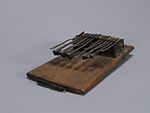sanza (Thumb Piano)
About this object
History of use
The sanza, or mbira (Shona language) is a plucked idiophone (or lamellaphone) that has been in use for thousands of years, and is played widely throughout the African continent. It is known by many different names, e.g., kilembe, likembe, kadono, akogo, timbrh, and thumb piano and has undergone variations, such as the kalimba, but the general style and function remain consistent. The instrument has been played for both secular and ceremonial use, e.g., around the fire during social evenings, or to commicate with the ancestors.
Specific techniques
Adding beeswax underneath the keys adds to the weight of the key which produces a bigger, stronger sound (Ngoma by H. Tracey. 1948. p. 24).
Physical description
Thumb piano constructed from a wooden plank base with five narrower, and seven thicker metal prongs raised up from the plank on a piece of wood and bent metal, and secured with a metal bar and wire. Each prong has a ball of resin or wax stuck underneath the end. There is a rattle composed of a metal bar with four metal cylinders attached to the edge opposite the end with the metal prongs. A skin handle is attached at the prong end through two holes in the wooden plank. A ridged geometric design, with an overall rectangular shape composed of four triangles, has been carved into the top face.
Categories
Materials
